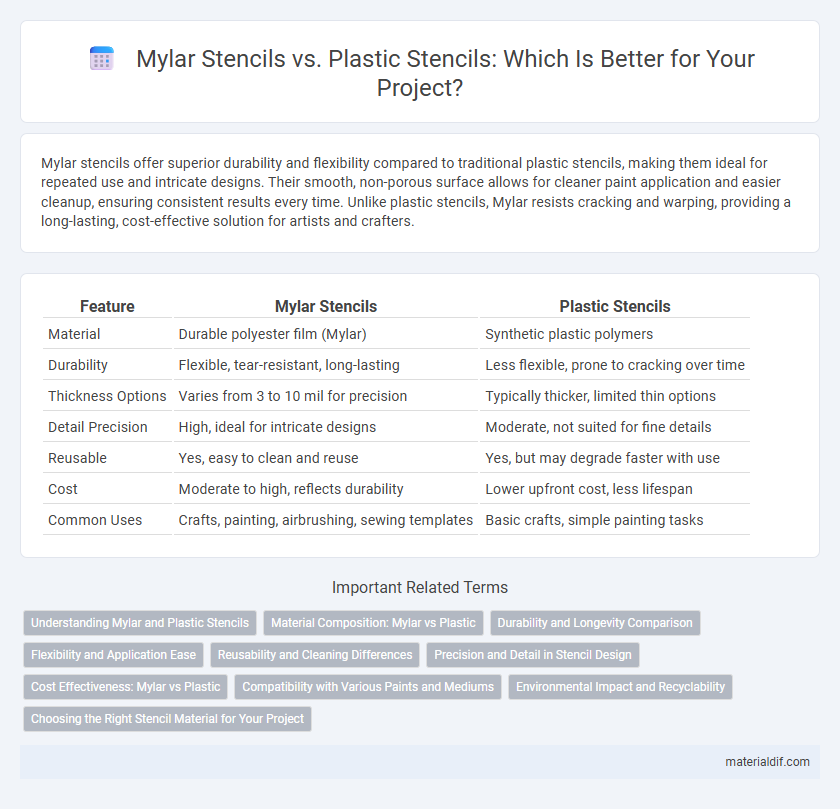Mylar stencils offer superior durability and flexibility compared to traditional plastic stencils, making them ideal for repeated use and intricate designs. Their smooth, non-porous surface allows for cleaner paint application and easier cleanup, ensuring consistent results every time. Unlike plastic stencils, Mylar resists cracking and warping, providing a long-lasting, cost-effective solution for artists and crafters.
Table of Comparison
| Feature | Mylar Stencils | Plastic Stencils |
|---|---|---|
| Material | Durable polyester film (Mylar) | Synthetic plastic polymers |
| Durability | Flexible, tear-resistant, long-lasting | Less flexible, prone to cracking over time |
| Thickness Options | Varies from 3 to 10 mil for precision | Typically thicker, limited thin options |
| Detail Precision | High, ideal for intricate designs | Moderate, not suited for fine details |
| Reusable | Yes, easy to clean and reuse | Yes, but may degrade faster with use |
| Cost | Moderate to high, reflects durability | Lower upfront cost, less lifespan |
| Common Uses | Crafts, painting, airbrushing, sewing templates | Basic crafts, simple painting tasks |
Understanding Mylar and Plastic Stencils
Mylar stencils offer superior durability and flexibility compared to traditional plastic stencils, making them ideal for multiple uses and intricate designs. Mylar is a polyester film known for its resistance to tearing and heat, which ensures consistent, clean lines during stencil application. Plastic stencils, often made from lower-quality polyethylene or PVC, can warp or degrade faster, impacting precision and longevity.
Material Composition: Mylar vs Plastic
Mylar stencils are made from biaxially-oriented polyethylene terephthalate (BoPET), offering exceptional durability, flexibility, and chemical resistance compared to conventional plastic stencils composed of polystyrene or polypropylene. The BoPET composition in Mylar provides higher tensile strength and superior dimensional stability, ensuring precision in repeated use without warping. Plastic stencils tend to degrade faster under solvent exposure and frequent cleaning, whereas Mylar maintains clarity and shape over extended periods.
Durability and Longevity Comparison
Mylar stencils offer superior durability compared to plastic stencils due to their flexible yet tear-resistant polyester film composition, enabling repeated use without deformation. The chemical resistance of Mylar allows it to withstand various paints and solvents, extending the stencil's longevity in diverse crafting and industrial applications. In contrast, conventional plastic stencils are prone to cracking and warping over time, diminishing their effectiveness and lifespan.
Flexibility and Application Ease
Mylar stencils offer superior flexibility compared to plastic stencils, allowing them to conform easily to curved and uneven surfaces for precise application. Their durability ensures repeated use without cracking or warping, making them ideal for intricate designs in arts, crafts, and cosmetic applications. Plastic stencils tend to be more rigid, limiting their adaptability and often requiring more effort to achieve clean, accurate results on varied surfaces.
Reusability and Cleaning Differences
Mylar stencils offer superior reusability compared to plastic stencils due to their durable polyester material, which resists tearing and deformation after multiple uses. Cleaning Mylar stencils is more efficient, as they can be easily wiped or soaked without losing shape, unlike plastic stencils that may warp or degrade with repeated exposure to solvents. The ability to maintain crisp edges and structural integrity makes Mylar stencils a preferred choice for intricate and frequent stencil applications.
Precision and Detail in Stencil Design
Mylar stencils offer superior precision and intricate detail retention compared to plastic stencils due to their smooth surface and higher durability. The flexibility of Mylar sheets allows for more accurate cuts and cleaner edges, making them ideal for detailed artwork and repeatable designs. Plastic stencils, while more rigid, often lack the fine detail capability and can degrade faster, resulting in less precise stencil applications.
Cost Effectiveness: Mylar vs Plastic
Mylar stencils offer superior cost effectiveness compared to plastic stencils due to their durability and reusability, reducing the need for frequent replacements. Unlike plastic stencils that may warp or crack over time, Mylar maintains its shape and flexibility, ensuring consistent stencil performance. Investing in Mylar stencils minimizes long-term expenses, especially for repetitive or large-scale projects.
Compatibility with Various Paints and Mediums
Mylar stencils offer superior compatibility with a wide range of paints and mediums, including acrylics, spray paints, and inks, due to their smooth, non-porous surface which prevents paint absorption and allows for easy cleaning. Plastic stencils often absorb some paint, leading to potential bleeding and less precise edges on detailed designs. Mylar's durability and resistance to chemical reactions make it a preferred choice for artists working with diverse painting materials and techniques.
Environmental Impact and Recyclability
Mylar stencils offer a more sustainable option compared to traditional plastic stencils due to their durability and reusability, significantly reducing single-use waste. Unlike many plastic stencils, Mylar sheets are recyclable and less likely to contribute to long-term environmental pollution. The superior longevity of Mylar minimizes the frequency of replacement, thereby lowering the overall environmental footprint associated with stencil use.
Choosing the Right Stencil Material for Your Project
Mylar stencils offer superior durability and flexibility compared to plastic stencils, making them ideal for repeated use on varied surfaces such as fabric, wood, and metal. Their resistance to chemicals and ease of cleaning ensure precision and longevity, which is essential for intricate designs or long-term projects. Choosing Mylar over plastic stencils reduces wear and tear, guaranteeing consistent results and higher-quality finishes for professional and hobbyist applications alike.
Mylar Stencils vs Plastic Stencils Infographic

 materialdif.com
materialdif.com